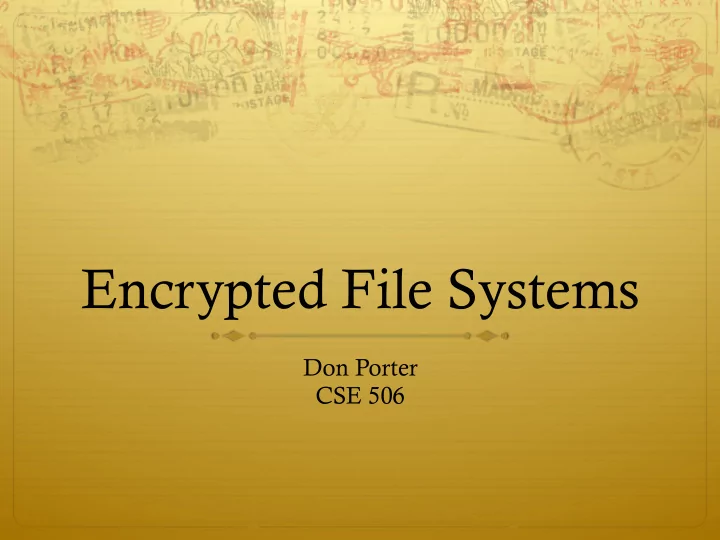

Encrypted File Systems Don Porter CSE 506
Goals ò Protect confidentiality of data at rest (i.e., on disk) ò Even if the media is lost or stolen ò Protecting confidentiality of in-memory data much harder ò Continue using file system features without losing confidentiality ò Example: Backup ò Low overheads (space and CPU) ò Change keys and perhaps different keys for different data
Two major approaches ò Block device encryption VFS ò Transparently encrypt entire partition/disk below the file system ext4 ò Linux: dm-crypt Encrypted block ò Windows: BitLocker device ò Mac: FileVault 2 Generic block device
Block encryption intuition ò File system is created on a virtual block device ò Low-level read of virtual block device: ò FS requests a block be read into page cache page X ò Map to block(s) on real device ò Request that blocks be read into a temporary page Y ò Decrypt page X into page X ò Return to file system ò Similarly, writes encrypt pages before sending to disk
Two major approaches ò File System encryption VFS ò Encrypt data between VFS/Buffer cache and Encrypted FS low-level file system ext4 ò Linux: eCryptFS ò Windows: EFS ò Mac: FileVault 1 Generic block device
File-based intuition ò Idea: Mount a layered file system over a real one ò Application writes encrypted file ‘foo’ ò Encrypted FS opens real file foo ò Stores some crypto metadata (like the cipher used) at the front ò Encrypts pages in page cache, transparently writes at an offset
File-based intuition ò Read of file ‘bar’ ò Encrypted FS asks real FS for file ‘bar’ ò Uses metadata + secret key to decrypt ò Stores decrypted pages in page cache ò Challenges: ò Managing private keys ò Enforcing read protection on decrypted data in page cache
Pros/Cons of disk encryption ò Pros: ò Hides directory structure, used space, etc Metadata matters! ò ò Can put any file system on top of it ò Cons: ò Everything encrypted with one key Encryption provides no confidentiality between users on a ò shared system ò Data must be re-encrypted before send on network ò Encryption overhead for public data (like /etc/hostname)
Vs. FS encryption ò Pros: ò Per-user (or per directory or file) encryption ò Only encrypt truly secret data ò Possibly send an encrypted file across network; use key (sent separately!) to decrypt on remote host ò Cons: ò Harder to hide/obfuscate directory structure and metadata ò More keys to manage ò Possibly easier to steal keys (debatable---harder to use TPMs)
Challenges ò Key management ò Read protection of live data ò Swapping ò Booting the OS
Key management ò Or, where do we keep the secret key? ò Not in the file system! ò There is a bootstrapping problem here ò Ideas?
Trusted Platform Module ò New hardware extension – common on PCs in last few years ò Either on motherboard or in CPU chip itself ò Provides two useful features: ò Measured Execution : Basically, checks that the booted code (BIOS, bootloader, OS) match a given hash ò Useful to detect tampering with your software ò Sealed Storage: Store a very small amount of data in non- volatile memory in the TPM chip ò Only accessible from code with hash that wrote it
TPM Idea ò Store the private key for the file system in the TPM’s sealed storage ò Only the trusted BIOS/bootloader/OS can access the decryption key ò The drive alone gets you nothing! ò Tampering with the OS image (on disk) to dump the disk contents gets you nothing!
Small problem ò Motherboard or CPU dies, taking TPM with it ò How to decrypt your files then? ò BitLocker: As part of initialization, allow user to print a page with the decryption key. Put this in a safe place (not laptop bag)
Key management in FS- level encryption ò Each user has a key chain of decryption keys ò Kernel is trusted with these keys ò On-disk, keychain is encrypted with a master key ò Master key is protected with a passphrase ò That just happens to be the logon credentials ò So, with a user’s passphrase, we can decrypt the master key for her home directory, then decrypt the keyring, then the home directory
Challenge 2 ò The unencrypted data in the page cache needs to be protected ò If I encrypt my home directory, but make it world readable, any user on the system can still read my home directory! ò Encryption is no substitute for access control!
Swapping ò Care must be taken to prevent swapping of unencrypted data ò Or keys! ò If part of the file system/key management is in a user daemon, unencrypted keys can be swapped ò One strategy: Swap to an encrypted disk ò Another strategy: Give the encrypted file system hooks to re- encrypt data before it is written out to disk ò Or put the swap file on the encrypted FS ò Subtle issue
Challenge 3: Booting ò You can’t boot an encrypted kernel ò Decryption facilities usually need a booted kernel to work ò Big win for FS encryption: Don’t encrypt files needed for boot ò Disk encryption: Usually puts files needed for boot on a separate (unencrypted) partition
Summary ò Two main types of encrypted storage: ò Block and file system encryption ò Understand pros and cons of each ò Understand key challenges: ò Key management ò Swapping ò Booting
Recommend
More recommend